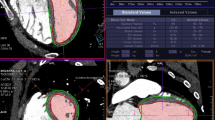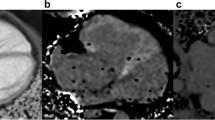Abstract
Background
Varying degrees of partial volume error depending on the complexity of the endocardial borders are inevitable in threshold-based cardiac computed tomography (CT) ventricular volumetry. These errors can potentially be reduced by using a partial voxel interpolation (PVI) method, but this has not been tested for cardiac CT ventricular volumetry.
Objective
To evaluate the partial volume error-reducing effects of the PVI method in cardiac CT ventricular volumetry among patients with congenital heart disease (CHD).
Materials and methods
The cardiac CT ventricular volumetry data were obtained from 55 patients (median age 12.0 years) with CHD. The ventricular and myocardial volumes, ejection fraction and ventricular mass-volume ratio were quantified and compared before and after the PVI method. The correlation between the myocardial volumes in the end-systolic and end-diastolic phases was tested. The effect of the PVI method on the classification of ventricular hypertrophy was evaluated.
Results
The indexed ventricular volumes after PVI were significantly smaller (7.4–11.5%) than those before PVI (P<0.001). In contrast, the indexed myocardial volumes were significantly larger (6.2–27.7%) after PVI (P<0.001). The ejection fractions and mass-volume ratios were significantly larger (1.6–2.2% and 19.7–42.5%, respectively) after PVI (P<0.001 and P<0.001, respectively). The indexed myocardial masses showed prominently high correlation between the end-systolic and end-diastolic phases (R, 0.961–0.990; P<0.001). The proportions of no and severe hypertrophy were significantly decreased (P<0.002) and increased (P<0.032), respectively, after the application of the PVI method.
Conclusion
The PVI method can reduce partial volume error in cardiac CT ventricular volumetry among patients with CHD.
Graphical abstract




Similar content being viewed by others
Data availability
Data will be available on reasonable request.
References
Burchill LJ, Mertens L, Broberg CS (2014) Imaging for the assessment of heart failure in congenital heart disease: ventricular function and beyond. Heart Fail Clin 10:9–22
Bussadori C, Di Salvo G, Pluchinotta FR et al (2015) Evaluation of right ventricular function in adults with congenital heart defects. Echocardiogr 32(Suppl 1):S38–S52
Muthurangu V (2021) Cardiovascular magnetic resonance in congenital heart disease: focus on heart failure. Heart Fail Clin 17:157–165
Goo HW (2019) Changes in right ventricular volume, volume load, and function measured with cardiac computed tomography over the entire time course of tetralogy of Fallot. Korean J Radiol 20:956–966
Lu JC, Christensen JT, Yu S et al (2014) Relation of right ventricular mass and volume to functional health status in repaired tetralogy of Fallot. Am J Cardiol 114:1896–1901
Goo HW (2018) Comparison between three-dimensional navigator-gated whole-heart MRI and two-dimensional cine MRI in quantifying ventricular volumes. Korean J Radiol 19:704–714
Freling HG, van Wijk K, Jaspers K et al (2013) Impact of right ventricular endocardial trabeculae on volumes and function assessed by CMR in patients with tetralogy of Fallot. Int J Card Imaging 29:625–631
van de Veerdonk MC, Dusoswa SA, Marcus JT et al (2014) The importance of trabecular hypertrophy in right ventricular adaptation to chronic pressure overload. Int J Card Imaging 30:357–365
Koch K, Oellig F, Oberholzer K et al (2005) Assessment of right ventricular function by 16-detector-row CT: comparison with magnetic resonance imaging. Eur Radiol 15:312–318
Goo HW (2019) Technical feasibility of semiautomatic three-dimensional threshold-based cardiac computed tomography quantification of left ventricular mass. Pediatr Radiol 49:318–326
Goo HW (2021) Right ventricular mass quantification using cardiac CT and a semiautomatic three-dimensional hybrid segmentation approach: a pilot study. Korean J Radiol 22:901–911
Codella NC, Weinsaft JW, Cham MD et al (2008) Left ventricle: automated segmentation by using myocardial effusion threshold reduction and intravoxel computation at MR imaging. Radiol 248:1004–1012
Codella NC, Lee HY, Fieno DS et al (2012) Improved left ventricular mass quantification with partial voxel interpolation: in vivo and necropsy validation of a novel cardiac MRI segmentation algorithm. Circ Cardiovasc Imaging 5:137–146
Goo HW (2018) Combined prospectively electrocardiography- and respiratory-triggered sequential cardiac CT in free-breathing children: success rate and image quality. Pediatr Radiol 48:923–931
Hong SW, Goo HW, Maeda E et al (2019) User-friendly, vendor-specific guideline for pediatric cardiothoracic computed tomography provided by the Asian Society of Cardiovascular Imaging (ASCI) Congenital Heart Disease Study Group: Part 1. Imaging Techn Korean J Radiol 20:190–204
Goo HW (2022) Optimal end-systolic cardiac phase prediction for low-dose ECG-synchronized cardiac CT. Eur J Radiol 151:109675
Goo HW (2011) Individualized volume CT dose index determined by cross-sectional area and mean density of the body to achieve uniform image noise of contrast-enhanced pediatric chest CT obtained at variable kV levels and with combined tube current modulation. Pediatr Radiol 41:839–847
Goo HW (2018) Comparison of chest pain protocols for electrocardiography-gated dual-source cardiothoracic CT in children and adults: the effect of tube current saturation on radiation dose reduction. Korean J Radiol 19:23–31
Goo HW (2018) Is it better to enter a volume CT dose index value before or after scan range adjustment for radiation dose optimization of pediatric cardiothoracic CT with tube current modulation? Korean J Radiol 19:692–703
Goo HW (2012) CT radiation dose optimization and estimation: an update for radiologists. Korean J Radiol 13:1–11
Weiss BA (2011) Fisher’s r-to-Z transformation calculator to compare two independent samples [Some people don’t like statistics? Web site] Available at: https://blogsgwuedu/weissba/teaching/calculators/fishers-z-transformation/ Assessed October 10, 2022
Goo HW (2019) Semiautomatic three-dimensional threshold-based cardiac computed tomography ventricular volumetry in repaired tetralogy of Fallot: comparison with cardiac magnetic resonance imaging. Korean J Radiol 20:102–113
Goo HW, Park SH (2020) Pattern analysis of left ventricular remodeling using cardiac computed tomography in children with congenital heart disease: preliminary results. Korean J Radiol 21:717–725
Hu H, Liu H, Gao Z, Huang L (2013) Hybrid segmentation of left ventricle in cardiac MRI using Gaussian-mixture model and region restricted dynamic programming. Magn Reson Imaging 31:575–584
Varga-Szemes A, Muscogiuri G, Schoepf UJ et al (2016) Clinical feasibility of a myocardial signal intensity threshold-based semi-automated cardiac magnetic resonance segmentation method. Eur Radiol 26:1503–1511
Chen C, Qin C, Qiu H et al (2020) Deep learning for cardiac image segmentation: a review. Front Cardiovasc Med 7:25
Ngo TA, Lu Z, Carneiro G (2017) Combining deep learning and level set for the automated segmentation of the left ventricle of the heart from cardiac cine magnetic resonance. Med Image Anal 35:159–171
Sugeng L, Mor-Avi V, Weinert L et al (2010) Multimodality comparison of quantitative volumetric analysis of the right ventricle. JACC Cardiovasc Imaging 3:10–18
Farber NJ, Reddy ST, Doyle M et al (2014) Ex vivo cardiovascular magnetic resonance measurements of right and left ventricular mass compared with direct mass measurement in excised hearts after transplantation: a first human SSFP comparison. J Cardiovasc Magn Reson 16:74
Goo HW, Park SH (2023) Identification of the rapid progression of right ventricular functional measures using three-dimensional cardiac computed tomography after total surgical correction of tetralogy of Fallot. Eur J Radiol 164:110856
Acknowledgements
We would like to thank Ms. Seon Young Goo for correcting the English language.
Author information
Authors and Affiliations
Contributions
All authors whose names appear on the submission (1) made substantial contributions to the conception or design of the work; or the acquisition, analysis or interpretation of data, (2) drafted the work or revised it critically for important intellectual content, (3) approved the version to be published and (4) agreed to be accountable for all aspects of the work in ensuring that questions related to the accuracy or integrity of any part of the work are appropriately investigated and resolved.
Corresponding author
Ethics declarations
Conflicts of interest
None
Additional information
Publisher’s note
Springer Nature remains neutral with regard to jurisdictional claims in published maps and institutional affiliations.
Rights and permissions
Springer Nature or its licensor (e.g. a society or other partner) holds exclusive rights to this article under a publishing agreement with the author(s) or other rightsholder(s); author self-archiving of the accepted manuscript version of this article is solely governed by the terms of such publishing agreement and applicable law.
About this article
Cite this article
Goo, H.W., Park, S.H. Partial voxel interpolation to reduce partial volume error of cardiac computed tomography ventricular volumetry in patients with congenital heart disease. Pediatr Radiol 53, 2528–2538 (2023). https://doi.org/10.1007/s00247-023-05734-2
Received:
Revised:
Accepted:
Published:
Issue Date:
DOI: https://doi.org/10.1007/s00247-023-05734-2




